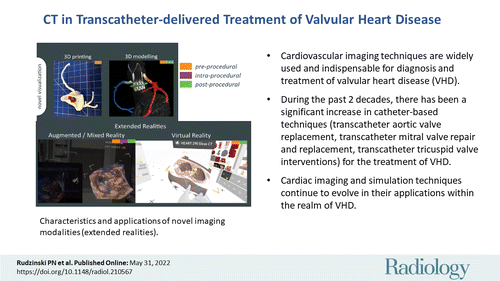Piotr Nikodem Rudziński, M.D., PhD, the recipient of a scholarship from the Professor Franciszek Walczak Programme, is the first author of the text titled CT in Transcatheter-delivered Treatment of Valvular Heart Disease in the prestigious journal Radiology.
The heart is one of the most important organs of the human body as the central hub of the circulatory system. It is a muscle that, unlike the others that make up the body, is never at rest. That is why it is so important to take care of the heart and develop those areas of medical sciences that allow us to intervene when its functioning is at risk. Cardiologists and cardiac surgeons, including those working in international teams, are constantly expanding their knowledge with a view to developing effective treatments for heart defects.
We spoke with Piotr Nikodem Rudziński, M.D., PhD, from the Cardinal Stefan Wyszyński Institute of Cardiology, recipient of a Walczak Programme scholarship, on minimally invasive methods of treating valvular heart defects, one of the most common cardiac conditions in Poland, as well as the role of cardiovascular imaging techniques and the significance of international cooperation in this area.
NAWA: It used to be difficult to imagine heart procedures that did not require opening the chest cavity and dissecting the sternum. Today, the role of minimally invasive methods is growing. What is the essence of these methods?
Piotr Nikodem Rudziński, M.D., PhD: It’s true! For instance, 20 years ago it was unthinkable to replace a diseased aortic valve without cardiac surgery on a stopped heart performed under extracorporeal circulation. Today, we can perform such a procedure without opening the chest cavity and the patient can go home just two days after the procedure. Interventional cardiology techniques used to treat coronary artery disease and structural defects involve entering the heart by puncturing an artery and/or peripheral vein and performing the procedure through the introduction of catheters, guidewires, implantable devices under radiological or echocardiographic guidance, or the application of intravascular imaging methods. The patient usually does not require general anaesthesia and is mobilised shortly after the procedure.
Which group of patients benefits most from these techniques as an effective alternative to surgery?
It is a great alternative and frequently the only treatment option for patients who are disqualified from conventional surgery due to excessive risk of death and complications, primarily elderly patients with underlying health conditions, as well as patients who have had a cardiac procedure in the past, for whom reopening the chest would be too risky. The main impetus for the emergence and development of these methods was the need to treat a group of patients who, due to excessive surgical risks, had nothing to gain from the medicine of the time beyond conservative treatment.
What role do cardiovascular imaging techniques play in the treatment of structural heart diseases?
It is safe to say that without modern preoperative and perioperative imaging techniques it would be impossible to perform interventional cardiology procedures. With these methods, we can plan a particular procedure in detail, choose the right equipment and select the most appropriate transcatheter treatment method. Real-time imaging techniques allow the procedure to be carried out precisely by determining anatomical relationships, hemodynamic conditions and the early effects of a given procedure live, providing the opportunity to correct and optimise it.

CT in Transcatheter-delivered Treatment of Valvuar Heart Disease, Piotr Nikodem Rudziński, in Radiology.
As part of the Walczak Programme, you completed an internship at MUSC Health in Charleston. Publication in the prestigious journal Radiology is one of the outcomes of the cooperation established during your stay. Is international mobility in the field of medical sciences important?
The article, published in the journal Radiology, is the result of international collaboration. It was written thanks to the involvement of experts from the US, Canada, Germany, Austria and Poland. Medical progress is possible only through the integration of international experience. Programmes such as the Professor Franciszek Walczak scholarship often contribute to the initiation of multi-year, multi-centre collaborations. Thus, it is safe to say that international mobility in the field of medical sciences can pave the way for new research projects.
Read an article: https://pubs.rsna.org/doi/10.1148/radiol.210567
Piotr Nikodem Rudziński, M.D., PhD works in the Department of Coronary and Structural Heart Disease at the Cardinal Wyszynski National Institute of Cardiology in Warsaw. In 2018, he was awarded the Franciszek Walczak scholarship for an internship at a selected medical centre in the US. He completed his internship at the Medical University of South Carolina in Charleston. Rudziński has also conducted research at Vienna General Hospital in Austria.
Radiology is a prestigious journal whose mission is to publish cutting-edge research articles relating to imaging in radiology and medical imaging. It is one of the world’s best and most popular trade journals with Impact Factor: 29,146. It has been published regularly since 1923 by the Radiological Society of North America (RSNA), which brings together radiologists, medical physicists and other medical imaging experts representing 31 specialties and 145 countries around the world.
Read more about Radiology https://pubs.rsna.org/journal/radiology
The Walczak Programme is a joint initiative of NAWA and the Ministry of Health. The aim of the programme is to strengthen the potential of Polish scientific units and medical entities by supporting the international mobility of researchers in the field of medical sciences. The programme provides support for international mobility – internships in top medical centres in the US lasting between 3 to 6 months. Two editions of the programme have been held so far, in 2019 and 2020. As many as 30 scientists and medical doctors have benefited from the scholarship. In Q1 2022, applications for the third edition of the programme were accepted.
Read more about: https://nawa.gov.pl/en/scientists/the-walczak-programme
